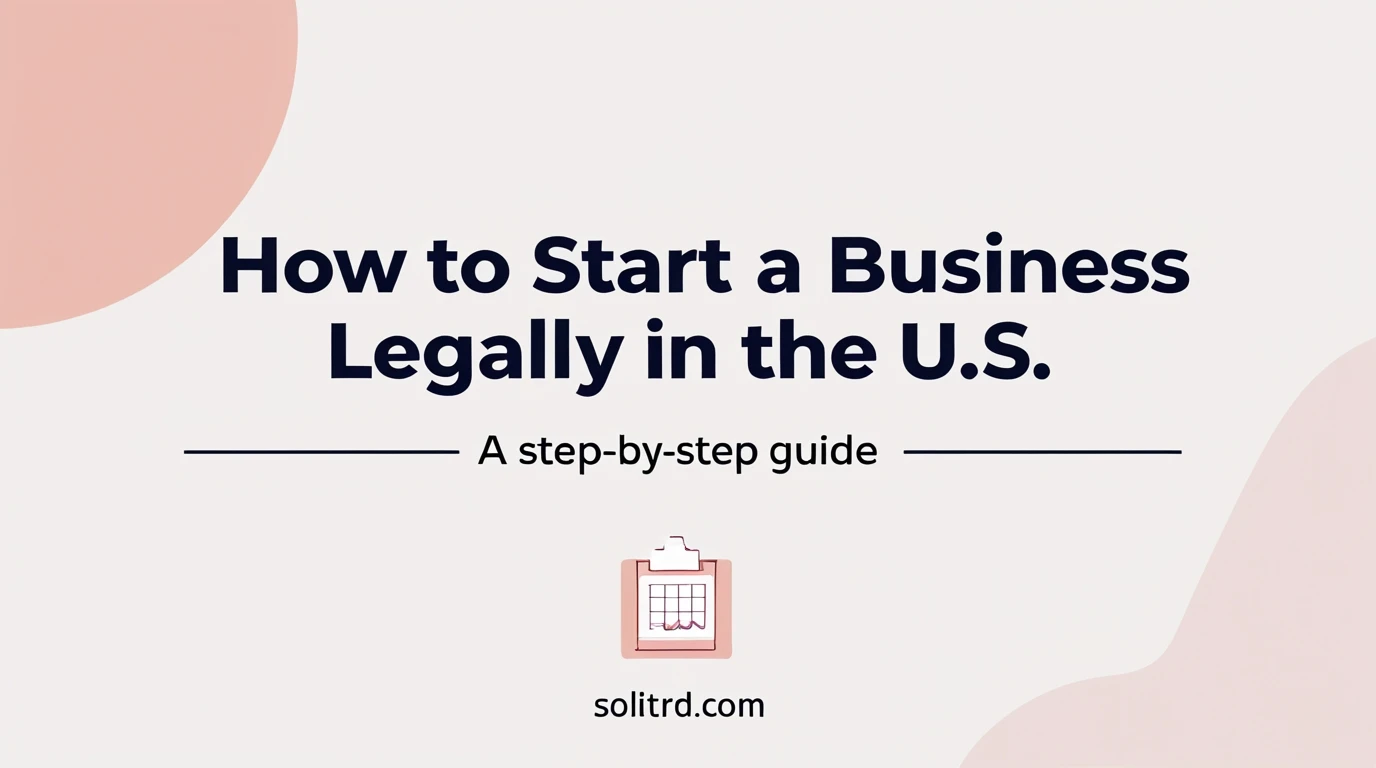How to Start a Business Legally in the U.S. – A Step-by-Step Guide

U.S. Starting a business is an exciting journey, but comes with legal steps to ensure your business is obedient and established to succeed. Whether you start a small start-up, an online store or a brick-and-mortar shop, it is important to understand the legal requirements. In this 1000-word guide, we will legally run through the process of starting a business in the United States, which is with practical, humanitarian tips to make it easy and acceptable. Let’s dive!
Why Legal Compliance Matters for Your Business
Before we enter the steps, let’s talk about why it is important to go on the legal path. Registration of your business properly protects your personal property, ensures tax compliance and creates confidence in customers and partners. Leaving these stages can close punishment, litigation or even your dream. By following this guide you will lay a strong base for development. Ready? Such is the United States to start a business legally
Step 1: Define Your Business Idea and Plan
Each successful business begins with a clear idea. Ask yourself: Which product or service will you offer? Who is your target audience? What problem do you solve? When you lower it, you create a business plan. This document emphasizes your goals, market research, budget and revenue estimates. This is not just a formality – it thinks of success as your road map.
- Tip: Keep your plan flexible. The market shifts, and so might your strategy.
- SEO Keywords: business idea, how to start a business, business plan tips
Step 2: Choose a Business Name
Your business name is your brand’s first impression. Pick something unique, memorable, and reflective of your vision. Then, check its availability:
- Search the U.S. Patent and Trademark Office (USPTO) database at uspto.gov to avoid trademark conflicts.
- Look up your state’s business name database (usually on the Secretary of State’s website).
- Check domain availability for your website (e.g., through GoDaddy or Namecheap).
Once confirmed, consider registering the name as a trademark for extra protection.
- Tip: Brainstorm 5-10 names in case your first choice is taken.
- SEO Keywords: choose business name, trademark a business name
Step 3: Select a Business Structure
Your business structure affects taxes, liability, and operations. Here are the main options:
- Sole Proprietorship: Simple, but you’re personally liable for debts.
- Partnership: For multiple owners, with shared liability.
- LLC (Limited Liability Company): Popular for small businesses; protects personal assets.
- Corporation (C-Corp, S-Corp): Ideal for larger businesses, with more complex tax and legal rules.
Most beginners opt for an LLC for its flexibility and protection. Research your options and consult a lawyer or accountant to decide.
- Tip: An LLC is great for solo entrepreneurs wanting low risk and simple taxes.
- SEO Keywords: business structure, LLC vs corporation, sole proprietorship
Step 4: Register Your Business
- Example: In California, file with the Secretary of State and pay a $70 fee.
- SEO Keywords: register a business, how to file an LLC, state business registration
Step 5: Get an EIN from the IRS
An Employer Identification Number (EIN) is like a Social Security number for your business. You’ll need it for taxes, banking, and hiring employees. Apply for free at irs.gov—it takes minutes online. Sole proprietors without employees can use their SSN, but an EIN is safer for privacy.
- Tip: Save your EIN confirmation in a secure place!
- SEO Keywords: get an EIN, IRS business number, employer identification number
Step 6: Open a Business Bank Account
Separate your personal and business finances to stay organized and legally protected. You’ll need your EIN, business registration, and ID to open a business bank account. Shop around for accounts with low fees and online banking perks.
- Why? Mixing funds can jeopardize your liability protection and complicate taxes.
- SEO Keywords: business bank account, separate business finances
Step 7: Obtain Licenses and Permits
Depending on your industry and location, you’ll need specific licenses or permits. Examples:
- Federal: Required for industries like agriculture, alcohol, or transportation (check usa.gov).
- State: General business licenses or professional licenses (e.g., for contractors).
- Local: City or county permits, like a sales tax permit or zoning approval.
Use the SBA’s tool at sba.gov to find what applies to you. Costs and rules vary widely.
- Tip: A restaurant in Texas might need a health permit, sales tax permit, and liquor license.
- SEO Keywords: business licenses, permits for small business, SBA licenses
Step 8: Understand Taxes and Register
Taxes can feel daunting, but here’s the basics:
- Federal Taxes: Income tax, self-employment tax (for sole proprietors), and employment taxes if you have staff.
- State Taxes: Sales tax, income tax, or franchise tax—check your state’s revenue department.
- Local Taxes: Property or local sales tax may apply.
Register for taxes with your state and the IRS. Consider hiring an accountant to avoid mistakes.
- Tip: Set aside 25-30% of profits for taxes to avoid surprises.
- SEO Keywords: business taxes, small business tax guide, register for taxes
Step 9: Get Business Insurance
Insurance protects against risks like lawsuits, property damage, or theft. Common types:
- General Liability: Covers accidents or customer claims.
- Professional Liability: For service-based businesses (e.g., consultants).
- Workers’ Comp: Required if you have employees.
Shop around for quotes from providers like Progressive or State Farm.
- Tip: A home-based business might need a rider on your homeowner’s policy.
- SEO Keywords: business insurance, general liability insurance, small business protection
Step 10: Comply with Employment Laws
If you’re hiring, follow federal and state labor laws:
- Verify employee eligibility with Form I-9.
- Withhold payroll taxes and report to the IRS.
- Follow minimum wage, overtime, and safety rules (check dol.gov).
Even if you’re solo now, plan for growth.
- SEO Keywords: employment laws, hiring for small business, labor compliance
Step 11: Set Up Bookkeeping
Track income, expenses, and receipts from day one. Use software like QuickBooks or Wave for ease. Good records simplify taxes and help you monitor growth. Consider a bookkeeper or accountant for peace of mind.
- Tip: Save receipts for business expenses—they’re tax-deductible!
- SEO Keywords: business bookkeeping, small business accounting, QuickBooks for beginners
Step 12: Launch and Market Your Business
You’re legal and ready! Now, build a website, create social media profiles, and spread the word. Comply with advertising laws—be honest and avoid false claims. Register your domain and consider SEO to attract customers.
- Tip: Start small—local ads or social media posts can go a long way.
- SEO Keywords: launch a business, small business marketing, SEO for startups
Final Thoughts
Starting a business legally in the U.S. takes effort, but it’s worth it. From choosing a name to securing permits, each step builds a strong, compliant foundation. Stay organized, seek expert advice when needed, and dream big! Have questions? Consult a lawyer, accountant, or the SBA for tailored guidance. Your entrepreneurial journey starts now—go make it happen!
Solitaire trains the brain by enhancing logic, attention, and thoughtful planning. It provides a calm, solo experience that eases stress and supports mental balance. The game teaches discipline, patience, and independent thinking. With its simple rules and quiet pace, solitaire is a healthy way to refresh the mind anytime.






